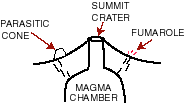
 A volcanic vent is an opening
exposed on the earth's surface where volcanic material is emitted.
All volcanoes contain a central vent underlying
the summit
crater
of the volcano. The volcano's cone-shaped structure, or edifice,
is built by the more-or-less symmetrical accumulation of lava
and/or pyroclastic
material
around this central vent system. The central vent is connected
at depth to a magma chamber, which is the main storage
area for the eruptive material. Because volcano flanks
are inherently unstable, they often contain fractures that descend
downward toward the central vent, or toward a shallow-level magma
chamber. Such fractures may occasionally tap the magma source
and act as conduits for flank eruptions along the
sides of the volcanic edifice. These eruptions can generate cone-shaped
accumulations of volcanic material, called parasitic
cones.
Fractures can also act as conduits for escaping volcanic
gases,
which are released at the surface through vent openings called
fumaroles.
A volcanic vent is an opening
exposed on the earth's surface where volcanic material is emitted.
All volcanoes contain a central vent underlying
the summit
crater
of the volcano. The volcano's cone-shaped structure, or edifice,
is built by the more-or-less symmetrical accumulation of lava
and/or pyroclastic
material
around this central vent system. The central vent is connected
at depth to a magma chamber, which is the main storage
area for the eruptive material. Because volcano flanks
are inherently unstable, they often contain fractures that descend
downward toward the central vent, or toward a shallow-level magma
chamber. Such fractures may occasionally tap the magma source
and act as conduits for flank eruptions along the
sides of the volcanic edifice. These eruptions can generate cone-shaped
accumulations of volcanic material, called parasitic
cones.
Fractures can also act as conduits for escaping volcanic
gases,
which are released at the surface through vent openings called
fumaroles.
 Summit Crater |
 Parasitic Cones |
 Fumarole |
Although every volcano has a unique eruptive history, most can be grouped into three main types based largely on their eruptive patterns and their general forms. The form and composition of the three main volcano types are summarized here:
|
TYPE |
SHAPE |
|
TYPE |
|
|
Straight sides with steep slopes; large summit crater |
|
|
|
|
Very gentle slopes; convex upward |
|
|
|
|
Gentle lower slopes, but steep upper slopes; concave upward; small summit crater |
|
|
SUBORDINATE VOLCANO TYPES -- Lava and tephra can erupt from vents other than these three main volcano types. A fissure eruption, for example, can generate huge volumes of basalt lava; however, this type of eruption is not associated with the construction of a volcanic edifice around a single central vent system. Although point-source eruptions can generate such features as spatter cones and hornitos, these volcanic edifices are typically small, localized, and/or associated with rootless eruptions (i.e., eruptions above the surface of an active lavaflow, unconnected to an overlying magma chamber) . Vent types related to hydrovolcanic processes generate unique volcanic structures, discussed separately under hydrovolcanic eruptions.
For a description of each of the main volcano types, see:
Classifying a volcano as active, dormant, or extinct is a subjective and inexact exercise. A volcano is generally considered active if it has erupted in historic time. This definition, however, is rather ambiguous, because recorded history varies from thousands of years in Europe and the Middle East, to only a few hundred years in other regions of the world, like the Pacific Northwest of the United States. Scientists generally consider a volcano active if it is currently erupting, or exhibiting unrest through earthquakes, uplift, and/or new gas emissions. The Smithsonian Institution's catalog of active volcanoes, recognizes 539 volcanoes with historic eruptions. In addition, there are 529 volcanoes that have not erupted in historic times, but which exhibit clear evidence of eruption in the past 10,000 years. These latter volcanoes are probably best considered "dormant," since they have the potential to erupt again.
Whether or not inactive volcanoes are considered truly extinct, or just dormant, depends partly on the average repose interval between eruptions. As noted in eruptive variability, explosive eruptions like those at Toba and Yellowstone have repose intervals of hundreds of thousands of years, whereas non-explosive eruptions have very short repose intervals. Thus, the Yellowstone region, which has not experienced an eruption for 70,000 years, can not be considered extinct. In fact, many scientists consider Yellowstone to be active because of high uplift rates, frequent earthquakes, and a very active geothermal system. Many inactive scoria cones, on the other hand, may be viewed as extinct shortly after they erupt, because such volcanoes are typically monogenetic and only erupt once.